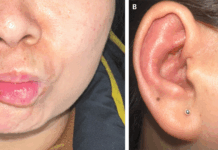Case of serpentine supravenous hyperpigmentation
A 58-year-old woman reported to the dermatology clinic with a 1-month history of a nonpruritic rash on her arms and a history of metastatic uterine leiomyosarcoma. Six weeks before her presentation, she began palliative treatment with gemcitabine and docetaxel, which she received via peripheral intravenous catheters. At the areas of previous intravenous access, hyperpigmented plaques were found on the dorsa of both hands. Panels A and B show how the darker skin extended up the arms in a linear manner following the network of superficial veins. The skin sores could be felt but were not painful. Based on the findings, docetaxel-associated serpentine supravenous hyperpigmentation was diagnosed.
Serpentine supravenous hyperpigmentation is a cutaneous adverse effect of a number of intravenous chemotherapy drugs, including docetaxel, vinorelbine, and – most commonly — 5-fluorouracil (5-FU). The mechanism of skin darkening is unknown, but the reaction is harmless; the underlying veins remain visible. The response can be avoided by infusing drugs using a central venous catheter. A central venous catheter was put in this patient in order to administer chemotherapy later. The rash had gone away at a follow-up visit two months later.
Pathogenesis
In 2-5% of patients receiving intravenous 5-FU, hyperpigmentation occurs. Hyperpigmentation is frequently associated with sun-exposed or X-ray-irradiated areas. Diffuse palmar pigmentation, transverse coloured bands over the interphalangeal joints, and pigmented macules of the palms, soles, nails, and oral mucosa are examples of pigmentary anomalies.
Serpentine supravenous pigmentation (SSP) is a rare adverse effect of 5FU that was first documented in 1976 by Hrushesky. Lesions frequently appear after numerous infusions, and subsequent injections usually worsen the hyperpigmentation. Despite the fact that 5-FU is the most commonly implicated medicine, serpentine supravenous pigmentation has also been reported with fotemustine, vinorelbine, and triazinate. When the offending medicine is removed, the pigmentation immediately fades.
The precise mechanism is unknown, however, it has been attributed to cytotoxic medicines
The precise mechanism of pigment induction is uncertain, but it has been proposed that these cytotoxic medicines promote endothelial dysfunction. This would allow the agent to leak from the vessel to the overlaying epidermis, where it would interfere with melanogenesis, resulting in hyperpigmentation. The streaks’ histopathology revealed strong dendritic melanocytes, enhanced basal melanin production, and the presence of melanophages in the papillary dermis. Typically, no inflammatory changes occur.
Pujol et al. identified a novel clinical entity that occurred after intravenous treatment of 5-FU. It was diagnosed as persistent supravenous erythematous eruption (PSEE) because of the erythematous, serpentine eruption over the veins. The lesion’s histopathology indicated interface dermatitis with basal cell vacuolization and necrotic keratinocytes. Despite clinical and histological differences, PSEE and SSP share a common cause and spread. Both show distinct patterns of a same cytotoxic effect; PSEE is caused by high cytotoxic keratinocyte destruction, whereas SSP is caused simply by epidermal hyperpigmentation.
Systemic 5-fluorouracil (5-FU) is commonly used in oncology to treat malignant neoplasms of the gastrointestinal tract, breast, pancreas, and head and neck region, either alone or in combination with other cytotoxic medications. Though uncommon, systemic 5-FU has been linked to a number of cutaneous adverse effects. Hyperpigmentation, photosensitivity, actinic keratosis inflammation, systemic contact dermatitis, facial eruptions similar to seborrheic dermatitis or lupus erythematosus, palmoplantar erythrodysesthesia, maculopapular eruption of the palms, palmar keratoderma, and folliculitis of the forehead are examples.
Source: NEJM




